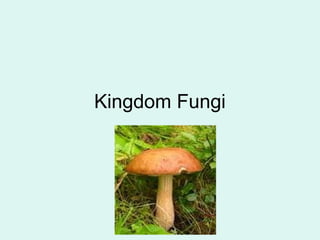Kingdom fungi.edited
•Télécharger en tant que PPT, PDF•
1 j'aime•1,998 vues
Fungi are eukaryotic organisms that have cell walls containing chitin. They are either multicellular with hyphae forming a mycelium, or unicellular like yeasts. Fungi obtain nutrients by secreting enzymes to break down dead or living matter and then absorbing the nutrients. They reproduce both asexually through spore formation or sexually through the fusion of gametes. Bread mold is an example of a zygomycete fungus with different hyphae types and a life cycle involving both asexual and sexual reproduction.
Signaler
Partager
Signaler
Partager

Recommandé
Embryonic and post embryonic development in insect

Embryonic and post embryonic development in insectIndian Agricultural Research Institute, Pusa Campus, New Delhi
Contenu connexe
Tendances
Embryonic and post embryonic development in insect

Embryonic and post embryonic development in insectIndian Agricultural Research Institute, Pusa Campus, New Delhi
Tendances (20)
Chapter VI – Insect Development and Life Histories

Chapter VI – Insect Development and Life Histories
Embryonic and post embryonic development in insect

Embryonic and post embryonic development in insect
Asexual reproduction, reproduction in organisms, neet biology

Asexual reproduction, reproduction in organisms, neet biology
Embryonic and post embryonic development in insects

Embryonic and post embryonic development in insects
En vedette (8)
Similaire à Kingdom fungi.edited
Similaire à Kingdom fungi.edited (20)
KOUSIK_GHOSHEVOLUTION-FUNGI2020-04-05EVOLUTION-FUNGI.ppt

KOUSIK_GHOSHEVOLUTION-FUNGI2020-04-05EVOLUTION-FUNGI.ppt
KOUSIK_GHOSHEVOLUTION-FUNGI2020-04-05EVOLUTION-FUNGI.ppt

KOUSIK_GHOSHEVOLUTION-FUNGI2020-04-05EVOLUTION-FUNGI.ppt
Introdution of fungi by brijesh pratap singh and ravindra chauhan

Introdution of fungi by brijesh pratap singh and ravindra chauhan
Plus de Jonard Cruz
Plus de Jonard Cruz (9)
Kingdom fungi.edited
- 2. Characteristics of Fungi – Fungi are eukaryotic heterotrophs that have cell walls. – Their cell walls contain chitin, a complex carbohydrate. – Except for yeasts, all fungi are multicellular – Fungi are made up of thin filaments called hyphae – Each hyphae is only one cell thick.
- 3. Characteristics of Fungi – The bodies of multicellular fungi are composed of many hyphae tangled together into a thick mass called a mycelium.
- 4. How do Fungi get their food? • Saprobes – secrete enzymes into dead organic matter and then absorb the nutrients from the decomposition • Ex. Mushrooms/ bread mold • Parasites – secrete enzymes onto things that are alive and absorb nutrients from the host • Ex. Ringworm/ “Athlete’s Foot”
- 5. How do Fungi Reproduce? – Most fungi reproduce both asexually and sexually. – Asexually by spore formation – Sexually by the fusion of primitive gametes
- 6. Structure and Function of Bread Mold • Black bread mold, Rhizopus stolonifer, is a zygomycete. (Division Zygomycota) • Black bread mold has three types of hyphae: • Rhizoids are rootlike hyphae that penetrate the bread's surface. • Stolons are stemlike hyphae that run along the surface of the bread. • Sporangiophores are strands of hyphae that support the spore case
- 7. Rhizopus Life Cycle of a Black Bread Mold FERTILIZATION MEIOSIS Sexual Asexual Reproduction Reproduction
